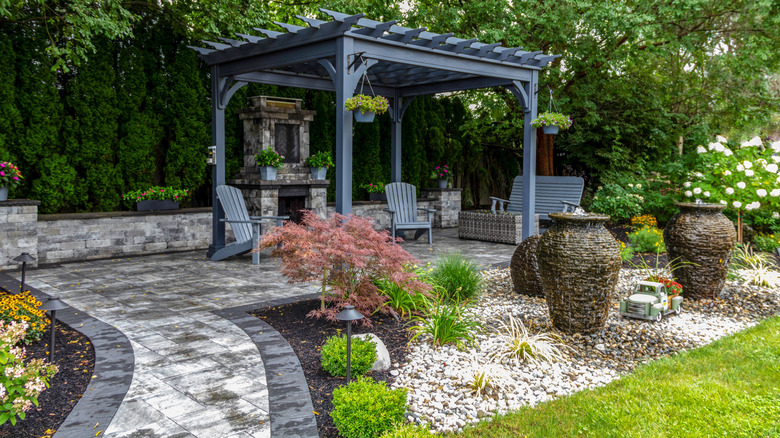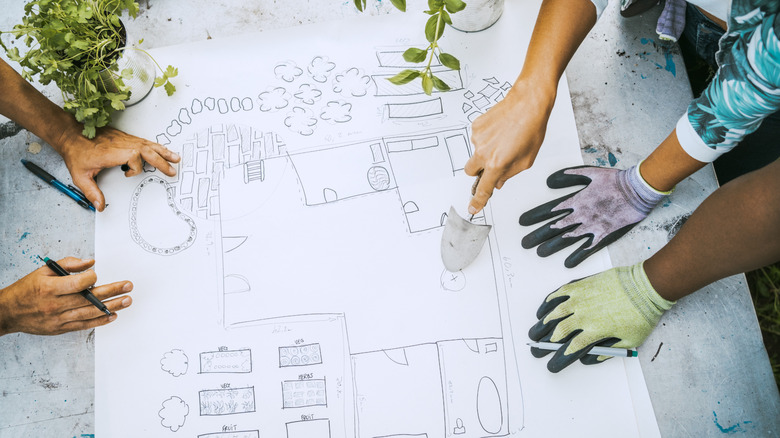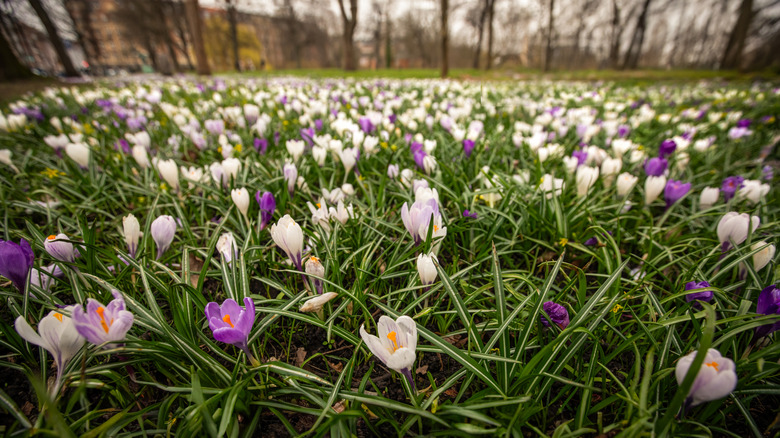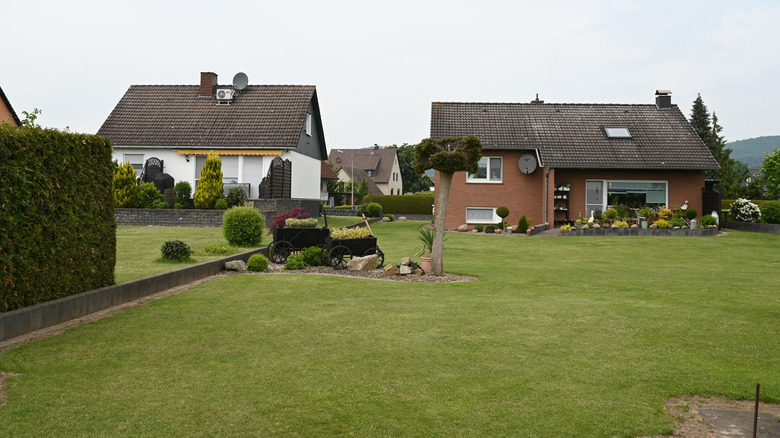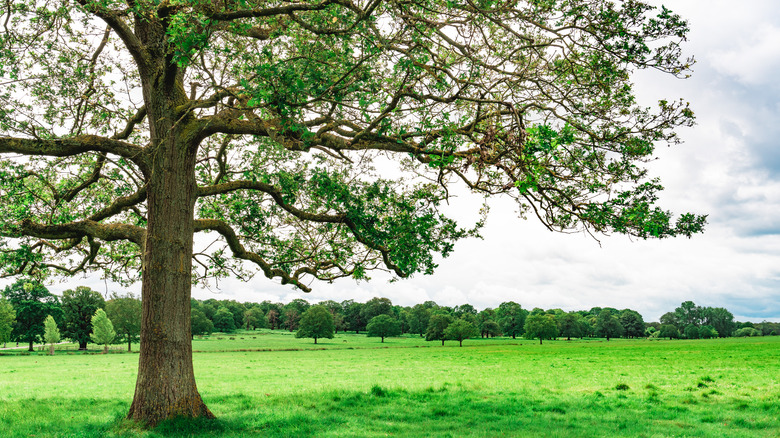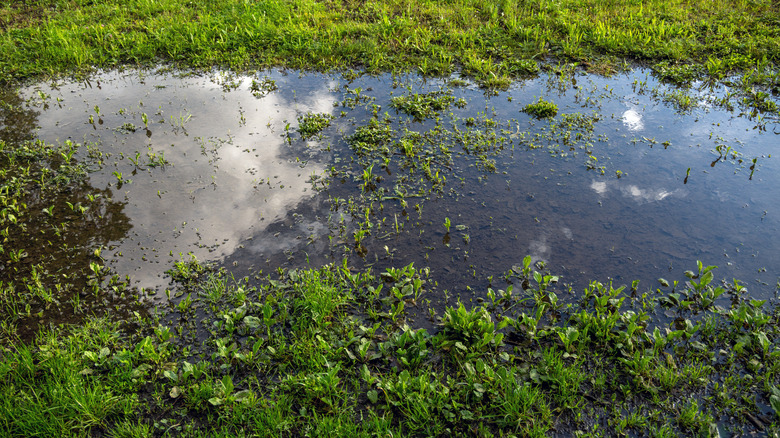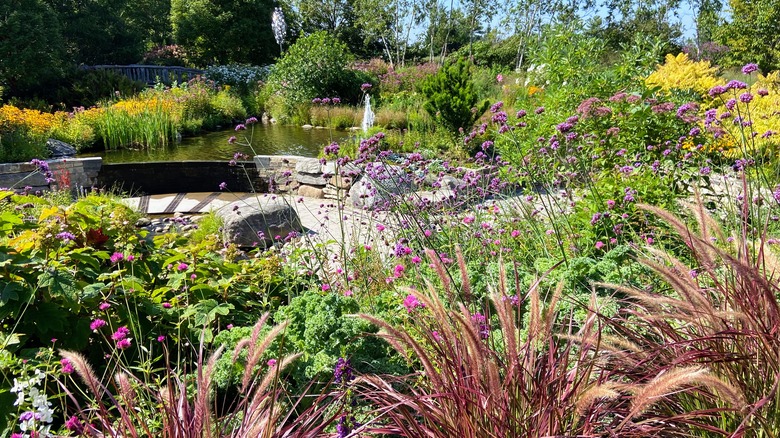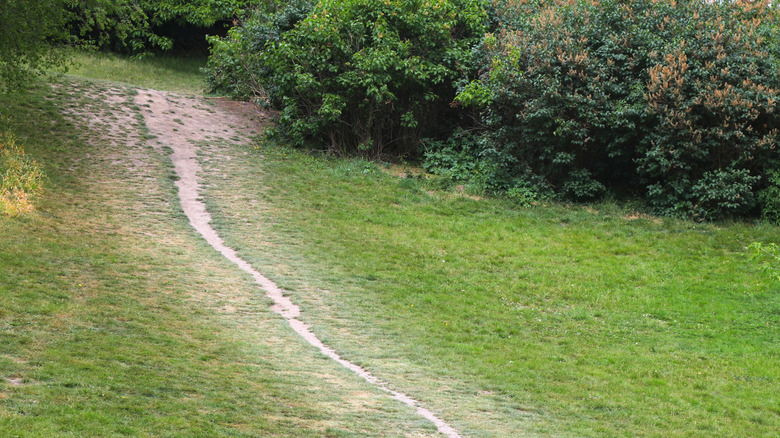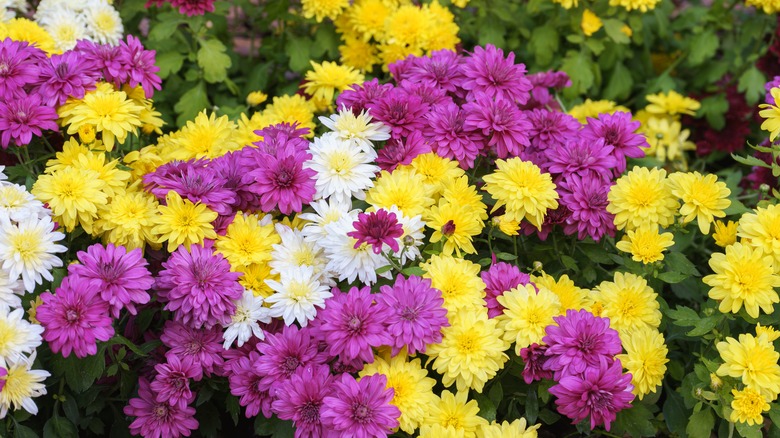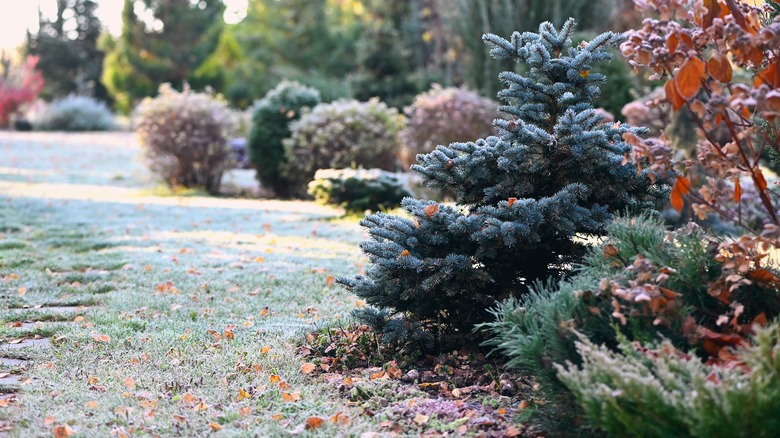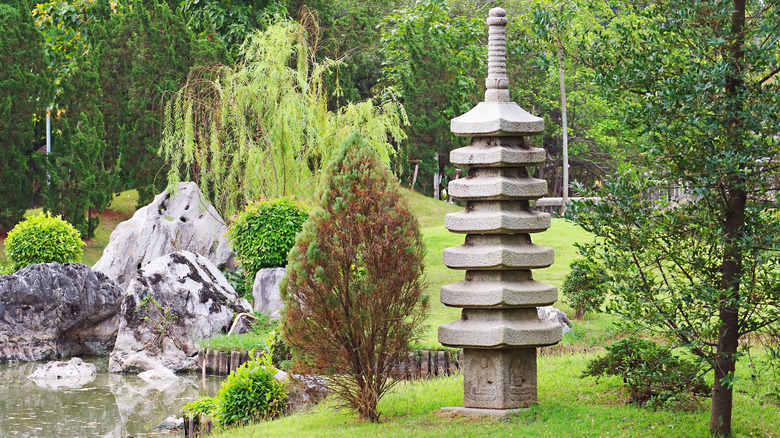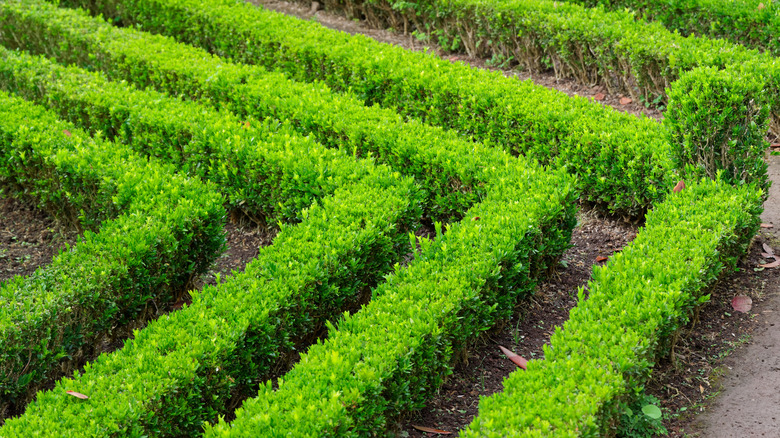The Biggest Mistakes To Avoid When Designing An Outdoor Garden
We may receive a commission on purchases made from links.
Whether you're starting from scratch on a completely blank lawn, or thinking of sprucing up an existing floral space, these are the biggest mistakes to avoid when designing an outdoor garden. You don't have to be in the Master Gardener program or a certified landscape architect to knock things out of the park with your project. However, failing to consider things like symmetry in your plantings, timing seasonal blooms, and the need for non-living elements in the space could leave you with a lopsided, all-brown, excruciatingly hot garden. Plus, you'll need to avoid the backyard design choices that are making it harder for you to sell your house.
Luckily, escaping all of this just takes a little bit of planning and problem-solving in the design phase. This way, the installation and enjoyment stages of your garden go off without a hitch. No matter your climate, budget, or HOA rules, a thoughtful design can still make all the difference. To succeed, focus on creating a layout that works with your lifestyle! Whether that means low-maintenance native plants, plenty of shaded seating areas, or even just designated zones for entertaining. Here's what to avoid (and what to do instead!).
Skipping a master plan
This is likely the biggest mistake you can make when designing an outdoor garden, especially if you are starting from scratch. While adding plants and features as you go can work on a smaller scale for just a couple of items, designing plant-by-plant for a larger space without a big-picture layout often leads to a disorganized garden lacking cohesion or structure. This can cost you more money in the long run, as you scramble to fix self-created problems like a lack of shade (but now nowhere to provide it!) or grading mistakes (which can lead to stagnant water and a pest issue).
To create a master plan, you can make a physical sketch of your property, including the correct dimensions, or use a digital option like AutoCAD, SketchUp, Revit, or specialized landscape software like Land F/X or DynaScape Design. Consider any pre-existing features of the land you will need to incorporate or remove, like trees, hills, ponds, barns, etc. Consider factors like your budget, any local HOA regulations, plus the USDA growing zone you are working within. Finally, if planting fruits and vegetables, consider grouping options by growth time and the care needed, so as not to disrupt any works in progress.Having everything down on paper (or digitally) before you get started will help you work through problems before they come up.
Lacking any vertical elements
Flat gardens can feel empty! When you are designing your outdoor space, think about adding vertical space to make it feel fuller. Things like pergolas, trellises, or even taller shrubs and trees can add the necessary height and rhythm. Of course, many vertical elements will need to be considered as a part of a longer-term plan, as the trees you plant that will grow for generations will likely still be quite small for some time.
The placement of these taller elements is just as important as their inclusion. You might add a gazebo in the center of the garden as the focal point for a form of radial symmetry, spiraling off and away from it. Trellises and mammoth trees, like oaks or pines, can line the edge of the space, defining its boundaries. To avoid a fence-like look (unless that's what you're going for), be sure to vary the height of the structures across the garden to encourage movement of the eye. However, be careful not to create a staircase by arranging plants in ascending or descending order. Instead, mix and match different options to play with proportion. An example of this might be taller grasses at one edge of a garden bed, with creeping thyme around it as a sort of medium option.
Poor balance between hardscape and softscape
One of the most common design pitfalls in garden planning is getting the balance between hardscape and softscape wrong. Your hardscape is all of the non-living elements in your garden — think things like patios, pathways, decks, fences, etc. Your softscape is all the living, growing stuff, like trees, flowers, and grass. When these two aren't properly balanced, the entire garden can feel off. That is, too much hardscape makes the space feel sterile, while too much soft can feel wild and cluttered.
To strike the right balance, you need to start with function in your design. Think about how you want to use the space. Do you need an outdoor BBQ area, a play zone for your dogs, or just a relaxing spot to read a book in the evening? Let that guide your hardscape layout, and then soften those structures with thoughtfully-placed plantings. For example, if you're creating a dining area on a stone patio, consider surrounding it with raised beds filled with herbs or low-maintenance flowering plants to add some color against the gray stone. Or, place your dog's kennel run behind the garage, so it doesn't interfere with the overall look of the garden, while still being able to serve its purpose. Or, install a birdbath near your outdoor reading nook to attract wildlife, and plant flowers around it, too — that sort of thing.
Planting without regard to scale
Scale is one of the most important aspects of your garden to consider when creating your master plan. You don't want a massive oak tree alongside a tiny patch of flowers, and that's it. This means thinking about how the size of your greenery and supporting structures relate to each other and to the overall layout of your yard. Plus, scale is not just about what the plants look like when they go in the ground. It's about how they'll look five or 10 years down the line. Not considering mature plant size is a common mistake that can lead to overcrowding, blocked views, or roots that interfere with walkways and foundations. For instance, planting a row of tiny arborvitaes too close to a fence might seem harmless at first, but give it a few seasons and it's a recipe for disaster. They'll be bursting through the slats or stealing all the sunlight from a nearby flower bed!
To navigate scale effectively, start by identifying a few "anchor" plants or items that will form the bones of your garden and provide height and shape year-round. You might choose to work around existing trees for this. Then, layer in medium-sized plants and accessories, such as growing hydrangeas or salvia (and a low garden bench!). This thoughtful approach to scale creates a garden that feels more intentional, and not to mention much easier to maintain as it matures.
Ignoring drainage and grading
All the beautiful design elements you choose for your garden will quickly fall apart if water doesn't flow properly throughout the space. This can create pooling, which leads to massive brown spots, pests, or even erosion. Properly grading your yard can protect your home from foundation damage, too.
If you are creating an outdoor oasis from scratch, pay careful attention to the grading of each area. A grade is the technical term for the slope of a feature, tilted just enough so that water gathers and runs off into the intended spots, instead of being stagnant. For lawns, you are looking at a slope of 1.5% to 10%, while patios should sit at 1% for the best results. When planning, consider where you want the water to flow and design around it. There are many ways to prevent overflow in your yard, like installing a French drain along the low points or using dry creek beds as both a design feature and a drainage solution. Even the most subtle of adjustments, like slightly sloping a pathway or adjusting the height of a raised flower bed, can help guide water to where it will do the most good and the least damage.
Underestimating the need for shade
It's easy to get swept up in choosing flowers and patio materials for the garden of your dreams, but without adequate shade, even the most beautiful garden can quickly become nearly unusable during the summer. Failing to plan for shade can also have a ripple effect on your garden's health. Plants can wilt or burn without enough protection, and certain outdoor furniture materials can deteriorate faster when constantly exposed to harsh UV rays. When designing a garden, shade isn't just a luxury. It's actually really important to observe your yard at different times of day throughout the year to determine where the shade needs to be, so your space stays easy to enjoy.
There are many options for creating shade, and the best designs often use a mix of them. Trees are a timeless solution that add character, habitat for wildlife, and natural cooling to other plants in your yard, protecting them from the harsh sun. However, they do take a while to grow. So, instead, for a faster or more flexible kind of shade, pergolas and temporary covers, like the AECOJOY Manual Retractable Awning, are also excellent choices. You can position them over dining or lounging areas to make those spots functional even during peak sun, then take them away in the evening to enjoy the stars.
Designing a space that you can't maintain
A lush, layered garden filled with winding paths, intricate plantings, and elaborate water features can be a dream come true ... until it's time for you to maintain it. Before committing to any design, ask yourself honestly: How much time do you actually have each week for garden tasks? For example, some experts suggest you'll need 1 to 3 minutes of time per square foot each week. That is, for a 50-square-foot garden, you'll need a minimum of 2 ½ hours of weekly maintenance. Do you enjoy gardening, or would you prefer to spend all that time relaxing? If you plan to hire help, does your budget allow for regular professional maintenance? It's important to be realistic about the ongoing effort your space will require. An overambitious plan can quickly turn into a source of stress and disappointment if the upkeep becomes unmanageable.
Smart garden design balances beauty with practicality. If you can't spend much time in your garden, opt for low-maintenance plants suited to your climate, like lantana, which comes in many colors, or pittosporum, which can grow quite tall. You can also invest in things that make overall maintenance easier, like 30 Seconds Outdoor Cleaner, which keeps mildew and other gunk off your patio spaces without the need for powerwashing, or a broadcast spreader, like the Scotts Turf Builder EdgeGuard Broadcast Spreader for spreading grass seed and fertilizer more quickly.
Not specifying entry points or pathways within the space
One often-overlooked aspect of garden design is the importance of clearly defined entry points, as well as pathways throughout the space. Without them, even a beautifully planted garden can feel disorganized or confusing. Visitors may not know where to step, how to access different areas, or how to move through the space comfortably. This becomes more important the larger your garden is! You don't want it feeling like a hedgemaze ... unless you've specifically included one.
Designing with clear entry points and walkways also protects your plants. Without designated routes, people are more likely to trample garden beds or create accidental shortcuts through delicate areas. By outlining where to walk and how to navigate the space, you not only improve usability, you also preserve the integrity of your design. Whether you use stepping stones, gravel, brick, or even mulch to make the pathways, they should feel intentional and accessible. However, gravel and mulch can be harder to maintain, as they must be replenished on occasion. Also keep scale in mind, as a path that's too wide might seem out of place, but a narrow path might not look like one at all.
Not incorporating different bloom times
It's easy to fall in love with a group of flowers that all bloom at once, especially when you're shopping during peak season. But, if every plant in your garden peaks in the same month, you'll be left with long stretches of green stems and empty patches for the rest of the year. This can make your garden feel like it's "off" more than "on," robbing you of seasonal interest and plenty of dynamic color. A staggered bloom schedule also adds rhythm and anticipation to your garden experience. There's always something to look forward to, and the space feels alive and changing, rather than static.
To make this a reality, try incorporating a mix of early, mid, and late-season bloomers. This way, your garden stays vibrant for longer. For example, you might plant tulips and daffodils for early spring cheer, coneflowers and daylilies for summer color, and asters and sedum to bring the garden to life again in the early fall. This kind of planning not only keeps your garden looking colorful for longer, but also supports pollinators throughout the growing season.
Relying solely on seasonal color
Depending on where you live, it would be a mistake to forget about what your garden might look like for more than half a year! In the northern part of the country, winter can really drag on. And in the south, your garden may not be covered in snow, but might be dead and brown when it's cold out. To avoid a dull, lifeless space during this time, it's important to think beyond seasonal flowers, even if they do bloom at different times of the year. To keep things lively, don't forget to add evergreen shrubs, ornamental grasses, and structural trees to the design mix, too. Plus, hardscape features like gazebos, birdbaths, raised garden beds, or even stone walls that kind of function as the "bones" of a landscape. These elements stay visually strong even when greenery fades, offering color and form through every season.
As you plan, think of things this way: Imagine the blooming flowers as fun accessories that add personality, while the evergreen plants and strong hardscape shapes are like the regular clothes that keep everything looking neat and balanced, no matter the time of year. This way, your garden offers beauty in every season, not just in spring.
Having an inconsistent style
Sure, there are plenty of outdated home styles we wish would come back, but this doesn't mean you need to try and incorporate every single style possible into your garden. For example, a sleek, modern patio surrounded by wild cottage-style plantings and framed by rustic fencing can feel disjointed rather than eclectic. While blending styles can work when done intentionally and with a unifying thread (like color, hardscape material, etc.), combining too many clashing elements often weakens the overall structure of the garden and muddles its identity. Even in professional botanic gardens, planners tend to separate different styles, like English cottage, Mediterranean, Japanese, etc.
To avoid a chaotic clash, start by defining the tone you want your garden to convey. Is it minimalist and clean, romantic and lush, or earthy and rustic? Do you want to draw from your local landscape (like a desert garden in Arizona) or one from a far-off place (like cherry blossoms and a pagoda from Japan). Let that vision guide your plant palette, hardscaping materials, furniture choices, and even garden accessories. If you do choose to mix styles, do so with intention and repetition. Try to echo colors, shapes, or textures to tie things together.
Forgetting symmetry or repetition
If you forget to include symmetry or repeating elements in your garden, it can end up looking messy or lopsided. Repetition is a subtle, but powerful, way to bring order to your garden. Using the same plants, shapes, or materials in different spots, and subtly mirroring each other, helps the eye move smoothly through the space and makes the whole garden feel more connected and balanced.
This doesn't mean every garden needs to be perfectly symmetrical — with matching sides like a formal estate from Victorian England — but some level of repetition, whether it's through recurring pavers, neatly clipped boxwoods, or flanked rows of the same flowering shrub, helps anchor the space. These repeating elements act like a visual thread, weaving together different parts of the garden and making it feel intentional, rather than randomly assembled. Even subtle patterns make a big difference. A curved metal edging that reappears in planters, or a specific bloom color that pops up in various beds, can pull the design together in a powerful way. Without this consistency, gardens can start to feel like a patchwork of disconnected ideas.
